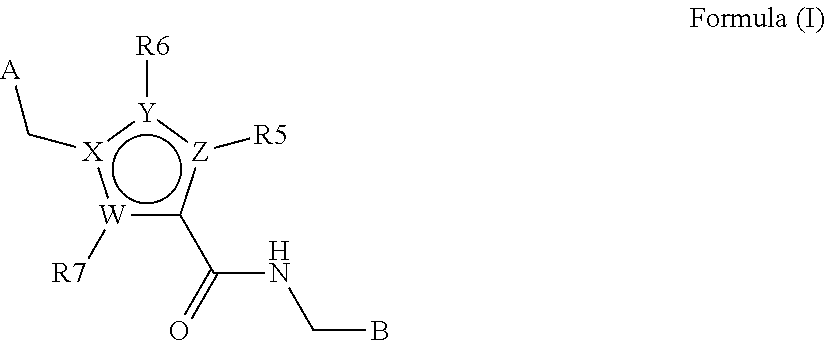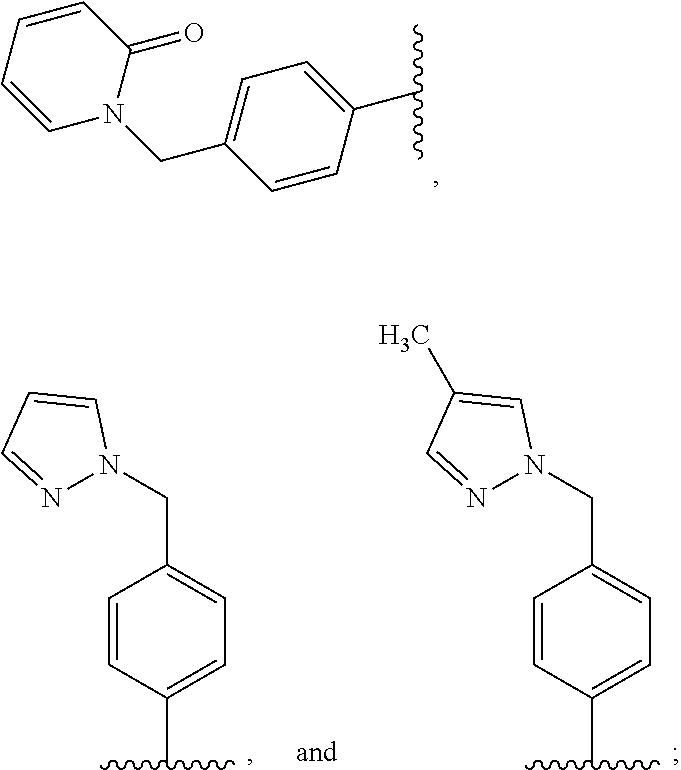N-((HET) arylmethyl)-heteroaryl-carboxamides compounds as plasma kallikrein inhibitors
a technology of n-heteroarylcarboxamides and compounds, which is applied in the field of heterocyclic derivatives, can solve the problems of limited molecule description, abnormal abundance of plasma kallikrein-kinin system, and no small molecule synthetic plasma kallikrein inhibitor has been approved for medical use, and achieves the effect of increasing the solubility of compounds of formula (i) used in the preparation of parenteral solutions
- Summary
- Abstract
- Description
- Claims
- Application Information
AI Technical Summary
Benefits of technology
Problems solved by technology
Method used
Image
Examples
example 1
N-(3,5-Dimethoxybenzyl)-3-(methoxymethyl)-1-(4-((2-oxopyridin-1(2H)-yl)methyl)benzyl)-1H-pyrazole-4-carboxamide
[0389]
[0390]To a mixture of 3-(methoxymethyl)-1-(4-((2-oxopyridin-1(2H)-yl)methyl)benzyl)-1H-pyrazole-4-carboxylic acid (80 mg, 0.226 mmol), (3,5-dimethoxyphenyl)methanamine (45.4 mg, 0.272 mmol) and HATU (95 mg, 0.249 mmol) in anhydrous DCM (1.5 mL) and anhydrous DMF (0.3 mL) was added N,N-diisopropylethylamine (99 μl, 0.566 mmol) and the mixture allowed to stir at rt overnight. The reaction was concentrated in vacuo and the residue purified by flash chromatography loading in DCM, eluting with a gradient of 1 to 10% MeOH (containing 0.3% NH3) / DCM to afford a gum. This was dissolved in acetonitrile (0.5 mL) and water (3 mL) added, forming a precipitate. This was sonicated, then filtered and dried under vacuum to afford N-(3,5-dimethoxybenzyl)-3-(methoxymethyl)-1-(4-((2-oxopyridin-1(2H)-yl)methyl)benzyl)-1H-pyrazole-4-carboxamide (76 mg, 0.150 mmol, 66.1% yield) as a sticky ...
example 2
3-Amino-1-[4-(2-oxo-2H-pyridin-1-ylmethyl)-benzyl]-1H-pyrazole-4-carboxylic acid 2-fluoro-3-methoxy-benzylamide
[0393]
[0394]3-Amino-1-[4-(2-oxo-2H-pyridin-1-ylmethyl)-benzyl]-1H-pyrazole-4-carboxylic acid (75 mg, 0.23 mmol) was dissolved in DCM (20 mL) and DMF (1 ml). This solution was cooled to 0° C. 2-Fluoro-3-methoxy-benzylamine hydrochloride (53 mg, 0.28 mmol) was added followed by HOBt (34 mg, 0.25 mmol) and triethylamine (70 mg, 0.69 mmol). Water soluble carbodiimide (53 mg, 0.28 mmol) was then added. The reaction mixture was stirred, allowed to warm to rt and stirred for 3 days. The mixture was diluted with chloroform (200 mL) and washed with NaHCO3 (aq) (50 mL), water (50 mL) and brine (50 mL), dried (Na2SO4) and evaporated in vacuo. The residue was purified by flash chromatography (silica), eluent 4% MeOH / 96% CHCl3, to give a white solid identified as 3-amino-1-[4-(2-oxo-2H-pyridin-1-ylmethyl)-benzyl]-1H-pyrazole-4-carboxylic acid 2-fluoro-3-methoxy-benzylamide (92 mg, 0.20 ...
example 3
1-(7-Chloro-quinolin-3-ylmethyl)-3-methoxymethyl-1H-pyrazole-4-carboxylic acid 2-fluoro-3-methoxy-benzylamide
[0397]
(7-Chloro-quinolin-3-yl)-methanol
[0398]7-Chloroquinoline-3-carboxylic acid (500 mg, 2.4 mmol) was dissolved in anhydrous THF (20 mL) and cooled to −20° C. To this solution was added triethylamine (1.0 mL, 7.23 mmol) and isobutyl chloroformate (0.38 mL, 2.9 mmol). The reaction mixture was stirred at −20° C. for 20 min and then poured into a solution of sodium borohydride (731 mg, 19 mmol) in water (2 mL) at 0° C. The reaction mixture was allowed to warm to rt and stirred for 18 hours. The mixture was diluted with EtOAc (50 mL) and the layers separated. The organic layer was washed with water (20 mL), brine (20 mL), dried (Na2SO4), filtered and evaporated in vacuo to give a yellow solid. The solid was purified by chromatography on silica, eluting with EtOAc / Pet Ether to afford (7-chloro-quinolin-3-yl)-methanol as an off white solid, 134 mg, 29% yield.
[0399][MH]+=194.1
3-Br...
PUM
| Property | Measurement | Unit |
|---|---|---|
| Force | aaaaa | aaaaa |
| Permeability | aaaaa | aaaaa |
| Plasma power | aaaaa | aaaaa |
Abstract
Description
Claims
Application Information
 Login to View More
Login to View More - R&D
- Intellectual Property
- Life Sciences
- Materials
- Tech Scout
- Unparalleled Data Quality
- Higher Quality Content
- 60% Fewer Hallucinations
Browse by: Latest US Patents, China's latest patents, Technical Efficacy Thesaurus, Application Domain, Technology Topic, Popular Technical Reports.
© 2025 PatSnap. All rights reserved.Legal|Privacy policy|Modern Slavery Act Transparency Statement|Sitemap|About US| Contact US: help@patsnap.com



